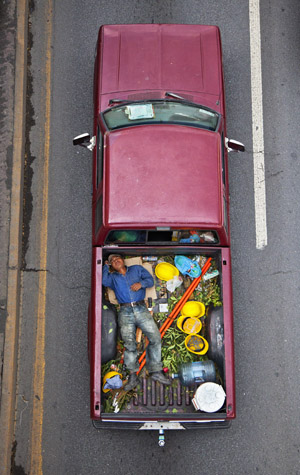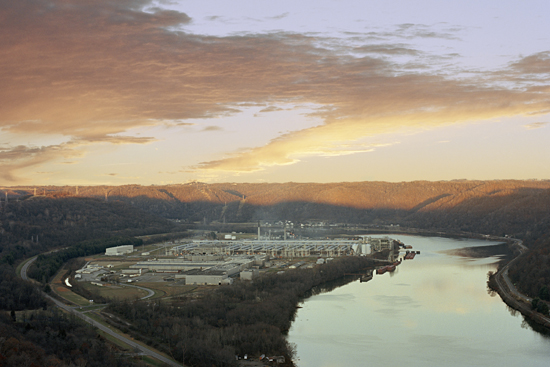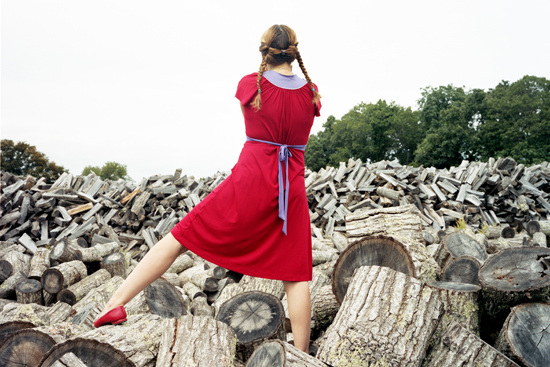Capturing the World in Color
BU’s Photographic Resource Center show honors four photographers

There was a time color photography was considered inferior to black-and-white, consigned to the pages of National Geographic, but largely absent elsewhere.
But color photography long ago became the norm, and a new exhibition—now in its final week—at the Photographic Resource Center at Boston University—suggests why. Leopold Godowsky, Jr., Color Photography Awards was named for the coinventor of Kodachrome film, which ushered in modern color photography. It features the work of four photographers who use color to striking effect in their work.
The competition is held every four years, and for this year’s, organizers asked curators, gallery owners, photography critics, and educators from around the world to suggest nominees. More than 150 artists submitted their work for consideration. This year’s show sought to highlight emerging artists and new approaches to color. The work of the winner and the three photographers receiving honorable mention make a compelling case for the power of color. The show demonstrates how color can enhance a photograph’s details, as well as the novel ways that artists approach color photography.
Looking at Alejandro Cartagena’s The Carpoolers, a series of photographs of pickup trucks ferrying workers to their jobs in Monterey, Mexico, it’s hard to imagine his images resonating the same way in black-and-white. Each of the nine photos, shot from a highway bridge, look down on truck cabs filled with workers. Each is shot from the same perspective and each is vertical, with the truck’s lines elongated by the painted highway lanes. In some, the workers are reading; in others they are talking on cell phones or sleeping. In some, the workers are hidden under cardboard boxes, in others they’re looking up at the highway overpass, keenly aware of the photographer. Cartagena’s color photography makes these images distinct from one another, with each truck standing out in eye-popping shades of white, blue, red. The detritus surrounding the workers in the back of each cab—hard hats, water bottles, tools, clothing—adds further punctuations of color. Cartagena—one of the honorable mentions in the show—makes each image unique.
The pictures are part of a larger body of work that considers the interrelationship of humans and the landscape they inhabit in the face of urban expansion. Looking at them, we peer at people who for the most part are unaware that they’re being photographed. Cartagena wants to make the viewer consider the numerous vehicles we see each day and the cargo they carry.

Most noticeable about Aaron Blum’s striking series of images of his home state of West Virginia, titled Born and Raised, is the sepia-like aura that suffuses much of the work. Ormet Aluminum, a photo of an aluminum plant, would in black-and-white be a stark image of an industrial site ringed by mountains. But Blum—another honorable mention—has shot the plant either just after sunrise or just after sunset, so the color and light soften the narrative. And he uses the sky’s palette of blues, golds, and lavenders as a contrast to the shadowy landscape below. Similarly, in The Hannibal Dam, he uses color to spectacular effect to suggest the encroachment of man and technology on nature. But, again, what could have been a gritty industrial image is transformed by color into something almost ethereal—the grays of the mist, the autumn foliage, the silver of the water.
Blum, an eighth generation West Virginian, notes in his artist statement that he is deeply aware of the negative connotations—often false—of his state. By shooting in color, he attempts to present a different image. “The warm southern sun creates a glow that pours out of the mountains, rivers, and forests, creating long shadows, dark recesses, and gray mists that blanket the landscape,” he writes. These color photographs serve as a counterpoint to the images of strip mining and rural poverty so often associated with the area.

Color is so central to Bastienne Schmidt’s photographs that it’s almost impossible to imagine them in black-and-white. Schmidt—the show’s third honorable mention—has created a series of interior and exterior tableaus titled Home Stills, drawing on Virginia Woolf’s A Room of One’s Own for inspiration. In many of the photographs, Schmidt, her face either turned away from the camera or obscured by fabric, stands in as a kind of everywoman housewife. In chromogenic prints like The Red Dress, Sagaponack, and Laundry Spiral, Bridgehampton, her color-saturated fantasias of suburban life exude a playfulness. “By never looking at the lens but away from it, I make the viewer a quiet observer of the strangeness and beauty of domestic life,” Schmidt writes in her artist statement.

The most striking photographs in the show are by Washington, D.C.–based photographer Louie Palu, who spent five years shooting in Afghanistan’s Kandahar province. Palu, the Leopold Godowsky, Jr., Color Photography Awards winner, submitted a series of photographs taken between 2007 and 2010, titled The Killing Season. They record time he spent with Afghan, US, and Canadian troops and the medics charged with collecting casualties. “My ultimate goal,” Palu’s artist statement says, “was to create a body of work which expressed the humanity, and inhumanity of war.” His use of color heightens the exhaustion and carnage of war. In Afghan Soldier Warming His Henna Stained Hands on the Front Lines, Zhari District, Kandahar, Afghanistan, the red provides a startling contrast to the piercing blue of the soldier’s eyes. The colors intensify the swirls of choking dust in Flying in Blackhawk through Dust and Smoke in Helicopter Landing Zone, Enemy Possible, Zhari District, Kandahar, Afghanistan. The pigment print—a chaotic mass of gray, green, yellow, and black—pulls the viewer right into the image. But nowhere does he use color more startlingly than in a photograph of medics treating wounded soldiers in a front line trauma room. All that can be seen of the medics are their legs and dusty army boots. But the eye is drawn to the dizzying amount of blood on the floor—brilliant red droplets are everywhere, the red so visceral that the image’s power would not have been possible in black-and-white.
As noted earlier, the use of new approaches to color was one of the criteria for judges in selecting the show’s finalists. The last of Kodak’s Kodachrome products was discontinued in 2009, at about the same time as the last Leopold Godowsky, Jr., Color Photography Awards competition. You get a sense of how much the landscape has changed since then from the work of the four artists represented in the current show. Schmidt’s photographs are chromogenic prints, Cartagena’s archival inkjet on cotton paper, Blum’s inkjet prints, and Palu’s are pigment prints. It makes one wonder what advances are in store for color photography and how talented photographers will use that technology to enhance their work.
Leopold Godowsky, Jr., Color Photography Awards is on exhibit at the Boston University Photographic Resource Center, 832 Commonwealth Ave., through Saturday, March 22; hours: Tuesday through Friday, 10 a.m. to 5 p.m., Saturday noon to 4 p.m., closed Sunday and Monday. The show is free and open to the public.

Comments & Discussion
Boston University moderates comments to facilitate an informed, substantive, civil conversation. Abusive, profane, self-promotional, misleading, incoherent or off-topic comments will be rejected. Moderators are staffed during regular business hours (EST) and can only accept comments written in English. Statistics or facts must include a citation or a link to the citation.